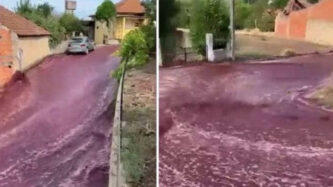Nick Squires The Telegraph | 11 September 2023

It is enough to make a connoisseur weep – the sight of millions of litres of red wine flooding down the streets of a Portuguese village.
The freak occurrence took place when two huge wine tanks burst at a distillery in Sao Lourenco do Bairro in the centre of the country.
Bemused locals watched as an estimated 2.2 million litres – equivalent to the water held in an Olympic-sized swimming pool – cascaded through the village on Sunday, swirling around street signs and parked cars.
Video footage showed the torrent of red wine flowing down a slope and around a bend in the road.
The wine flooded the basement of one house, though much of it was diverted into fields, Portuguese media reported.
There were fears that it could contaminate a nearby river, but local authorities said they had managed to prevent that from happening.
The distilling company, Levira, apologised for the damage and said it took full responsibility for the unusual accident.
“The causes of the incident are being investigated by the competent authorities. We are fully committed to covering the costs associated with cleaning up and repairing the damage, with teams ready to act immediately. We are committed to resolving this situation as quickly as possible,” the company said.
‘The miracle of Settecani’
The incident came three years after locals in a village in Italy were delighted when they found that red wine, rather than water, started pouring out of their taps.
The bizarre water-into-wine mix-up happened in the village of Settecani in the northern region of Emilia-Romagna.
The local winery, Cantina Settecani, is connected to the public water supply, but a valve malfunction during maintenance work meant that instead of water being piped into its bottling plant, sparkling Lambrusco started flowing in the other direction.
“[Our] staff intervened fairly quickly, much to the disappointment of the locals, some of whom had started bottling it,” Luisa Malaguti, a representative of the company, told The Telegraph at the time.
“People are talking about it as ‘the miracle of Settecani’ and comparing it to the story of Jesus turning water into wine.”
The reality was more prosaic.
“The problem was traced to the malfunction of a valve. The pressure of the wine was greater than that of the water and the wine flooded into the public water network,” Ms Malaguti said.



